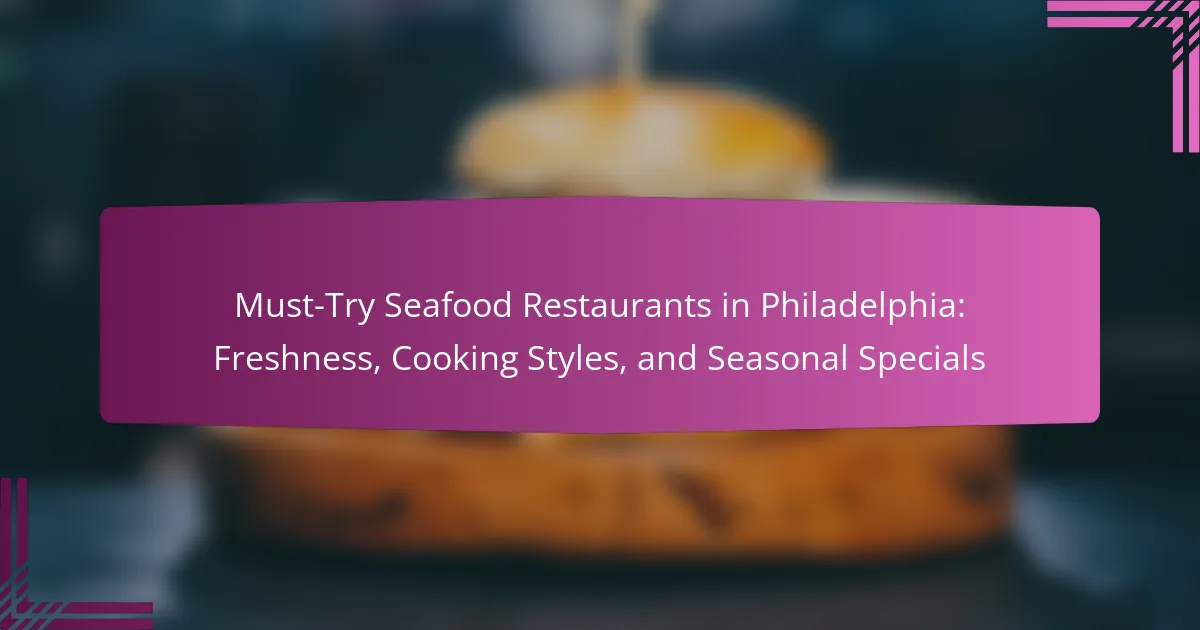
What are the Best Fine Dining Experiences in Philadelphia?
The best fine dining experiences in Philadelphia include Zahav, Fork, and Vedge. Zahav offers modern Israeli cuisine and has received numerous accolades, including a James Beard Award. Fork features seasonal American dishes and emphasizes local ingredients. Vedge specializes in innovative plant-based cuisine, showcasing the versatility of vegetables. Each restaurant provides a unique ambiance that enhances the dining experience. Zahav’s atmosphere reflects its cultural heritage, while Fork has a contemporary yet warm setting. Vedge creates a vibrant and artistic environment. These establishments consistently rank highly in reviews and culinary guides.
How do we define fine dining in Philadelphia?
Fine dining in Philadelphia is characterized by high-quality cuisine, exceptional service, and an upscale atmosphere. Restaurants in this category often feature meticulously crafted menus that showcase seasonal and local ingredients. The dining experience typically includes a formal setting with elegant decor and attentive staff. Many fine dining establishments in Philadelphia have received accolades, such as Michelin stars or James Beard awards, highlighting their culinary excellence. Reservations are often recommended due to the popularity of these venues. Additionally, fine dining often includes wine pairings curated by knowledgeable sommeliers. Overall, the definition encompasses a comprehensive experience that elevates dining beyond mere sustenance.
What characteristics distinguish fine dining restaurants?
Fine dining restaurants are distinguished by their high-quality food, exceptional service, and elegant ambiance. These establishments typically offer a curated menu featuring gourmet dishes made from premium ingredients. Service in fine dining is attentive, often with a high staff-to-guest ratio ensuring personalized attention. The ambiance is sophisticated, often characterized by upscale decor, soft lighting, and comfortable seating. Additionally, fine dining restaurants may have a dress code that encourages patrons to dress elegantly. Many also provide a comprehensive wine list, featuring selections from prestigious vineyards. Reservations are often recommended or required, reflecting the exclusivity of the experience. Overall, these characteristics create a unique dining experience that emphasizes luxury and refinement.
How does the fine dining experience differ from casual dining?
The fine dining experience differs from casual dining primarily in its level of service and ambiance. Fine dining establishments offer a formal atmosphere with meticulous attention to detail. This includes elegant decor, table settings, and often a dress code. In contrast, casual dining has a more relaxed environment with simpler decor and no specific dress requirements.
Service in fine dining is typically more attentive and personalized. Waitstaff in fine dining restaurants are often highly trained and knowledgeable about the menu. They may provide recommendations and detailed explanations of dishes. Casual dining staff may not offer the same depth of service or menu knowledge.
Menu offerings also vary significantly. Fine dining menus often feature gourmet dishes prepared with high-quality ingredients. These dishes may include unique flavor combinations and artistic presentations. Casual dining menus tend to focus on comfort food and familiar dishes, prioritizing quantity and affordability over culinary innovation.
Pricing in fine dining is generally higher due to the quality of ingredients and level of service. Casual dining is more budget-friendly, appealing to a wider audience. The overall dining experience in fine dining is designed to be an event, while casual dining is often about convenience and comfort.
Why is Philadelphia a notable city for fine dining?
Philadelphia is a notable city for fine dining due to its diverse culinary scene and acclaimed chefs. The city boasts numerous Michelin-starred restaurants, showcasing high-quality cuisine. Philadelphia’s dining establishments often emphasize local ingredients, reflecting the region’s agricultural richness. Renowned chefs like Marc Vetri and Michael Solomonov have made significant contributions to the city’s reputation. The city’s culinary landscape includes a mix of traditional and innovative dining experiences. Philadelphia also hosts various food festivals that celebrate its gastronomic culture. The vibrant food scene attracts both locals and tourists alike. Overall, Philadelphia is recognized for its exceptional dining options and culinary creativity.
What culinary influences shape Philadelphia’s dining scene?
Philadelphia’s dining scene is shaped by a mix of historical, cultural, and regional influences. The city has a rich history of immigration, bringing diverse culinary traditions. Italian, Irish, and German cuisines have significantly impacted local food culture. Additionally, Philadelphia is known for its iconic dishes like the cheesesteak and soft pretzels. The influence of local farms and artisan producers enhances the farm-to-table movement in the area. The city’s proximity to the Atlantic Ocean also contributes to a strong seafood presence in its dining options. Overall, these factors create a vibrant and eclectic culinary landscape in Philadelphia.
How does Philadelphia’s history contribute to its fine dining culture?
Philadelphia’s history significantly influences its fine dining culture. The city is known as the birthplace of American cuisine, blending diverse culinary traditions. Historic markets, such as Reading Terminal Market, showcase local ingredients and artisanal products. This availability of fresh, local produce informs chefs’ menus and innovations. Philadelphia’s rich immigrant history introduces various flavors and cooking techniques. Influential chefs often pay homage to traditional dishes while incorporating modern twists. The city’s historical landmarks and vibrant neighborhoods enhance the dining experience. Fine dining establishments often reflect Philadelphia’s cultural heritage in their decor and ambiance. Overall, Philadelphia’s historical context shapes its unique and evolving fine dining scene.

Who are the prominent chefs in Philadelphia’s fine dining scene?
Prominent chefs in Philadelphia’s fine dining scene include Michael Solomonov, known for his Israeli cuisine at Zahav. Another key figure is Jennifer Carroll, celebrated for her work at Spice Finch. Additionally, Marc Vetri is recognized for his Italian culinary expertise at Vetri Cucina. These chefs have significantly influenced the city’s gastronomic landscape. Their restaurants often receive accolades, showcasing innovative menus and high-quality dining experiences.
What are the backgrounds of notable Philadelphia chefs?
Notable Philadelphia chefs often have diverse and rich backgrounds. Many chefs in Philadelphia have formal culinary training from prestigious institutions. For example, Marc Vetri studied at the Culinary Institute of America. He later honed his skills in Italy. Other chefs, like Michael Solomonov, have roots in different cultures. Solomonov is originally from Israel and incorporates Middle Eastern flavors into his cuisine.
Some chefs have extensive experience working in renowned restaurants before opening their own. For instance, Jennifer Carroll worked in top kitchens in New York City. She later became a prominent figure in Philadelphia’s culinary scene. Additionally, many chefs are influenced by family traditions and local ingredients. This connection to their heritage often shapes their culinary style.
Overall, the backgrounds of notable Philadelphia chefs reflect a blend of formal education, international experience, and personal history.
Which chefs have received accolades for their work in fine dining?
Daniel Boulud, Jean-Georges Vongerichten, and Marc Forgione have received accolades for their work in fine dining. Daniel Boulud has earned multiple Michelin stars for his flagship restaurant, Daniel, in New York City. Jean-Georges Vongerichten holds several Michelin stars across his restaurants, including Jean-Georges in Manhattan. Marc Forgione, a winner of “Top Chef,” has received accolades for his innovative approach at his eponymous restaurant, Marc Forgione. These chefs are recognized for their exceptional culinary skills and contributions to fine dining.
How do these chefs influence the local culinary landscape?
These chefs influence the local culinary landscape by introducing innovative techniques and unique flavor profiles. They often incorporate locally sourced ingredients, which supports nearby farmers and producers. Their menus frequently reflect seasonal changes, promoting sustainability. Chefs also create signature dishes that become local favorites, drawing food enthusiasts to their establishments. Collaborations between chefs foster a sense of community and culinary exchange. Events such as pop-up dinners and food festivals showcase their creativity and attract attention to Philadelphia’s dining scene. Their presence elevates the city’s reputation as a culinary destination. This dynamic impacts local dining trends and inspires upcoming chefs in the region.
What signature dishes do these chefs create?
It is not possible to answer the question regarding the specific signature dishes created by the chefs in the context of the article “Best Fine Dining Experiences in Philadelphia: Chef Profiles, Menu Innovations, and Ambiance” without additional information about the chefs and their culinary creations.
How do these dishes reflect the chefs’ culinary philosophies?
The dishes reflect the chefs’ culinary philosophies through their innovative techniques and ingredient choices. Each chef emphasizes local sourcing, showcasing seasonal produce in their creations. This commitment highlights their belief in sustainability and supporting local farmers. The presentation of the dishes often merges art and food, illustrating a philosophy that values aesthetics as much as flavor. Traditional techniques are often reimagined, demonstrating a respect for culinary heritage while pushing boundaries. Flavors are thoughtfully balanced, showcasing the chefs’ understanding of taste profiles. Ultimately, these elements combine to create a dining experience that aligns with their culinary visions.
What ingredients are commonly used in their signature dishes?
Common ingredients in signature dishes at fine dining establishments in Philadelphia include fresh seafood, seasonal vegetables, and artisanal cheeses. Chefs often emphasize local produce to enhance flavor and sustainability. Proteins such as grass-fed beef and free-range poultry are frequently featured. Additionally, unique spices and herbs are used to elevate the dishes. These ingredients reflect the chefs’ commitment to quality and innovation. Many restaurants source their ingredients from nearby farms, ensuring freshness. This practice supports local agriculture and enhances the dining experience.

What innovations are shaping the menus in Philadelphia’s fine dining restaurants?
Innovations shaping the menus in Philadelphia’s fine dining restaurants include farm-to-table sourcing, global flavors, and plant-based options. Chefs are increasingly prioritizing local ingredients to enhance freshness and sustainability. This trend supports local farmers and reduces carbon footprints. Additionally, global culinary influences are being integrated, showcasing diverse cuisines and techniques. This reflects the city’s multicultural landscape. Plant-based dishes are gaining popularity, catering to health-conscious diners and those with dietary restrictions. Many establishments are experimenting with unique flavor pairings and innovative cooking methods. These innovations contribute to a dynamic dining experience that evolves with consumer preferences.
How are seasonal ingredients influencing menu designs?
Seasonal ingredients significantly influence menu designs by ensuring freshness and sustainability. Chefs often adjust their menus to reflect the availability of local produce. This practice enhances flavor profiles and supports local farmers. Seasonal menus can attract diners seeking unique dining experiences. Research shows that 70% of consumers prefer restaurants that use seasonal ingredients. Additionally, seasonal menus can reduce food waste by utilizing ingredients at their peak. Chefs can create dishes that celebrate specific seasons, enhancing culinary creativity. Overall, seasonal ingredients lead to innovative and dynamic menu offerings.
What are the benefits of using locally sourced ingredients?
Using locally sourced ingredients enhances the quality and freshness of dishes. Fresh ingredients often have superior flavor and nutritional value. They are typically harvested at peak ripeness, which maximizes taste. Local sourcing supports regional farmers and reduces transportation emissions. This practice fosters community relationships and sustainability. Additionally, it allows chefs to create seasonal menus that reflect local produce availability. Research shows that local food systems can contribute positively to local economies. According to the USDA, local food sales reached $11.7 billion in 2015, indicating strong consumer support for local sourcing.
How do chefs incorporate sustainability into their menu innovations?
Chefs incorporate sustainability into their menu innovations by sourcing local and seasonal ingredients. This practice reduces carbon footprints associated with transportation. Many chefs also prioritize organic and non-GMO products. This choice supports environmentally friendly farming practices. Additionally, some chefs utilize whole animal butchery to minimize waste. This method ensures that every part of the animal is used. Chefs often create dishes that highlight plant-based options. This shift can lower greenhouse gas emissions from meat production. Furthermore, many restaurants implement composting and recycling programs. These initiatives help reduce overall waste in the kitchen.
What unique dining experiences are offered in Philadelphia?
Philadelphia offers unique dining experiences such as themed restaurants, historic dining venues, and chef-driven concepts. Themed restaurants like the medieval-themed “The Medieval Banquet” provide immersive dining. Historic venues like “The City Tavern” serve colonial-inspired dishes in an 18th-century setting. Chef-driven concepts, such as “Vernick Food & Drink,” focus on innovative seasonal menus. Additionally, “Reading Terminal Market” offers a diverse range of local food vendors. These experiences reflect Philadelphia’s rich culinary heritage and creativity.
How do tasting menus enhance the fine dining experience?
Tasting menus enhance the fine dining experience by offering a curated selection of dishes. These menus provide guests with a journey through the chef’s culinary vision. Each course is designed to showcase unique flavors and techniques. The experience encourages exploration of diverse ingredients and pairings. Additionally, tasting menus often include smaller portions, allowing diners to sample more dishes. This variety can lead to a more memorable dining experience. Many fine dining establishments craft tasting menus to highlight seasonal ingredients. This approach ensures freshness and supports local producers.
What role does wine pairing play in menu innovation?
Wine pairing enhances menu innovation by creating complementary flavor profiles. This practice encourages chefs to experiment with diverse ingredients. It allows for the development of unique dishes that resonate with wine characteristics. Pairing can elevate the dining experience, making it memorable. Statistics show that 75% of diners appreciate curated wine pairings. This preference drives restaurants to innovate their menus continuously. Chefs often create seasonal dishes that align with specific wine selections. This synergy between food and wine fosters creativity in culinary offerings.

What ambiance can diners expect in Philadelphia’s fine dining establishments?
Diners can expect an elegant and sophisticated ambiance in Philadelphia’s fine dining establishments. Many restaurants feature upscale decor, including fine table settings and ambient lighting. Soft music often enhances the dining experience, creating a relaxed atmosphere. High-quality service is a hallmark, with attentive staff catering to guests’ needs. Some venues incorporate local art, adding a unique cultural touch. The overall environment is designed to provide a memorable experience. This ambiance reflects Philadelphia’s rich culinary scene and commitment to excellence.
How does ambiance contribute to the overall dining experience?
Ambiance significantly enhances the overall dining experience by influencing mood and perception. A well-designed ambiance can create a welcoming atmosphere. Elements such as lighting, music, and decor play crucial roles. For example, dim lighting often promotes intimacy. Soft background music can enhance relaxation and enjoyment. Research indicates that diners rate their experience higher in aesthetically pleasing environments. A study by Spence, et al. (2014) found that ambiance affects taste perception. This shows that ambiance is not merely a backdrop but a vital component of dining satisfaction.
What design elements are common in Philadelphia’s fine dining restaurants?
Common design elements in Philadelphia’s fine dining restaurants include elegant lighting, upscale furnishings, and curated artwork. Elegant lighting often features chandeliers or soft, ambient fixtures that create a warm atmosphere. Upscale furnishings typically consist of high-quality materials, such as leather or polished wood. Curated artwork enhances the dining experience by adding a unique aesthetic appeal. Many restaurants incorporate open layouts to foster a sense of community. Additionally, color palettes often consist of muted tones to promote a sophisticated ambiance. Textured fabrics on seating and drapery contribute to the overall luxury feel. These design choices reflect the city’s culinary heritage and commitment to an elevated dining experience.
How does lighting affect the dining atmosphere?
Lighting significantly influences the dining atmosphere by setting the mood and enhancing the overall experience. It affects how food is perceived and enjoyed. Warm, dim lighting creates an intimate setting, encouraging relaxation and conversation. Bright lighting, on the other hand, can energize a space and promote a lively atmosphere. Studies show that lighting can alter appetite and food perception. For instance, a study by the Cornell University Food and Brand Lab found that softer lighting can increase food enjoyment. Therefore, the choice of lighting is crucial in fine dining establishments to create the desired ambiance.
What are the best practices for enjoying a fine dining experience in Philadelphia?
To enjoy a fine dining experience in Philadelphia, make reservations in advance. Many top restaurants have limited seating and high demand. Dress appropriately for the restaurant’s ambiance. This often means business casual or upscale attire. Arrive on time to respect the dining schedule. Familiarize yourself with the menu beforehand. This can enhance your dining experience and allow for informed choices. Engage with the staff for recommendations on food and wine pairings. They can provide valuable insights into the menu. Take your time to savor each course. Fine dining is about the experience, not just the meal. Lastly, show appreciation through a proper tip. A standard tip is 15-20% of the total bill.
How should diners approach menu selections for the best experience?
Diners should approach menu selections by considering their preferences and dietary restrictions. Start by reviewing the entire menu to identify appealing dishes. Look for seasonal ingredients, as they often indicate freshness and quality. Pay attention to chef’s specials, which can showcase unique creations. Consider pairing options, such as wine or cocktail recommendations, to enhance flavors. Asking the server for suggestions can provide additional insight into popular or signature dishes. Finally, balance your selections with a variety of flavors and textures for a well-rounded experience. This approach ensures a satisfying dining experience tailored to individual tastes.
What tips can enhance the overall enjoyment of fine dining?
To enhance the overall enjoyment of fine dining, consider the following tips. First, dress appropriately for the venue. Many fine dining establishments have a dress code that contributes to the atmosphere. Second, make a reservation in advance. This ensures you have a table and can avoid long wait times. Third, arrive on time to respect the restaurant’s schedule and your dining companions. Fourth, engage with the staff. Asking questions about the menu can enhance your experience and show appreciation for their expertise. Fifth, savor each course. Take your time to enjoy the flavors and presentation of each dish. Lastly, consider pairing your meal with the suggested wine. This can elevate the dining experience by complementing the flavors of the dishes. These practices contribute to a more enjoyable and memorable fine dining experience.
The main entity of the article is the fine dining experiences in Philadelphia. This article provides an overview of top fine dining establishments, including Zahav, Fork, and Vedge, highlighting their unique cuisines, atmospheres, and accolades. It defines fine dining characteristics, compares it to casual dining, and explores the city’s notable chefs and their culinary influences. Additionally, the article discusses menu innovations, the importance of seasonal and locally sourced ingredients, and the role of ambiance in enhancing the dining experience. Overall, it presents a comprehensive look at Philadelphia’s vibrant fine dining scene.


